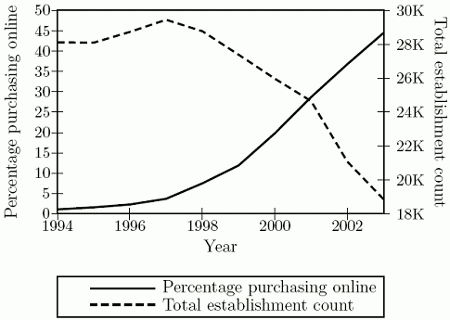E-commerce accounts for hundreds of billions of dollars in sales annually in the US and in Europe, and that figure is growing rapidly. The price effects of internet shopping, and e-commerce in general, have received a lot of research attention (see for example Brynjolfsson and Smith 2000, Scott Morton et al. 2001, Brown and Goolsbee 2002, Baye et al. 2007, and Ellison and Ellison 2009). The findings of this research have been drawn on in policy discussions of subjects like net neutrality and the tax treatment of online sales.
But the diffusion of e-commerce through an industry is likely to affect more than just prices. Market structure likely changes as well, as reduced consumer search costs lead to a wave of creative destruction. The tools of e-commerce make it easier for consumers to find lower-price sellers, meaning lower-cost firms (or those able to deliver higher quality at the same cost) will grab larger shares of business away from their higher-cost competitors.
Even if the more competitive landscape created by lower search costs reduces prices and margins as the above research has shown, this market structure response could be large enough that low-cost firms actually become more profitable as e-commerce spreads. High-cost firms, on the other hand, are doubly hit. Not only does their pricing power fall, but their market share falls too, as customers who were once captive – either because of ignorance or lack of alternatives – move on to better options elsewhere. Some of these firms will be forced out of business altogether.
Winners and losers from e-commerce
There has been less research attention directed toward such questions of which businesses most benefit and most suffer (perhaps to the point of having to cease operations) from e-commerce than that applied toward the implications for prices. Conventional wisdom suggests that market structure impacts could be large; the rapid growth of online travel sites at the expense of local travel agencies is one oft-cited example. In a recent paper (Goldmanis et al. 2010), my coauthors and I explore how the advent and diffusion of e-commerce can impact market structure. We look in detail at three industries often perceived to have been considerably impacted by e-commerce: travel agencies, bookstores, and new auto dealers.
Theory and evidence
The type of market structure effects discussed above arise naturally from a model where firms with varying production costs sell to a set of consumers who differ in their search costs. Consumers engage in costly search when deciding from which firm to buy, and firms set prices given consumers’ optimal search behaviour as well as their own and their rivals’ production costs. Firms have to cover fixed costs to operate and enter the industry. The model predicts the price results documented in the earlier research. Lower consumer search costs (that is, a leftward shift in the distribution) caused by the introduction of e-commerce reduces both the equilibrium average price level and price dispersion. More importantly for our discussion here, however, the model also predicts that lower search costs lead the industry’s low-cost firms to grow and the industry’s high-cost firms to shrink and sometimes even exit.
These theorised market structure implications are apparent in the data. Figure 1 contrasts the total number of travel agency offices in the US with the prevalence of online shopping among consumers during the period that e-commerce saw its initial widespread adoption by consumers.[1] The diffusion of internet shopping coincided with a culling of travel agency offices. After essentially holding steady until 1997, the number of offices fell by over 35% between 1997 and 2003. Total industry employment (not shown in the figure) also dropped precipitously, falling 26% over the same six years.
Figure 1. Fraction of consumers purchasing online and total travel agency offices, 1994-2003
Yet a look at Table 1 indicates this devastation at the aggregate level was not even across the industry’s businesses. The table breaks out the total industry establishment counts in Figure 1 by employment size category. (While county business patterns data are reported annually, the tables below show only every third year for the sake of brevity.) While there were sizable drops in the number of offices in each of the four smallest employment categories, the number of offices with 50 or more employees actually rose. Indeed, the number of operations with 100 or more employees grew by 70%, even in spite of a post-9/11 drop across all employment categories between 2000 and 2003. The vicious shake-out at the low end was therefore accompanied by growth among the industry’s largest businesses.
Table 1. Industry establishment counts (US aggregates), travel agencies
|
|
|
Employment Category
|
|
Year
|
Total
|
1-4
|
5-9
|
10-19
|
20-49
|
50-99
|
100+
|
|
1994
|
28,118
|
18,186
|
6,774
|
2,121
|
759
|
169
|
109
|
|
1997
|
29,452
|
19,183
|
6,758
|
2,332
|
834
|
206
|
139
|
|
2000
|
25,975
|
16,783
|
5,836
|
2,091
|
845
|
234
|
186
|
|
2003
|
18,860
|
12,865
|
3,556
|
1,430
|
653
|
182
|
174
|
If we accept that size is a proxy for firms’ costs, these patterns are consistent with the theory. Indeed, a considerable body of research has documented that higher cost firms in an industry tend to be smaller – see for example, Bartelsman and Doms (2000). A decline in search costs, made possible through the diffusion of the internet and the advent and improvement of travel-shopping websites, shifted equilibrium activity to the larger, lower-cost/higher-quality offices in the industry.
Similar patterns are observed among bookstores and new car dealers. While the number of bookstores with fewer than 20 employees fell by over one-fourth during the sample period, those with more than 20 employees more than doubled (see Table 2). This growth was particularly pronounced among the 50-99 employee size category.
Table 2. Industry establishment counts (US aggregates), bookstores
|
|
|
Employment Category
|
|
Year
|
Total
|
1-4
|
5-9
|
10-19
|
20-49
|
50-99
|
100+
|
|
1994
|
13,520
|
6,625
|
3,840
|
2,198
|
708
|
102
|
47
|
|
1997
|
12,301
|
5,254
|
3,753
|
2,021
|
933
|
286
|
54
|
|
2000
|
11,662
|
4,641
|
2,953
|
2,349
|
1,163
|
485
|
71
|
|
2003
|
11,036
|
4,493
|
2,900
|
1,909
|
1,237
|
428
|
69
|
Among new car dealerships, there were drops in the number of dealerships in the 10-19 and 20-49 employee categories – just under 20% in the former case and 10% in the latter (see Table 3). Yet, as with the other two industries, the number of larger-sized dealerships in the industry grew. Those with 50-99 employees rose by 20%, those with 100-249 employees saw about a 60% increase, and the number of dealerships with more than 250 employees tripled.
Table 3. Industry establishment counts (US aggregates), new car dealers
|
|
|
Employment Category
|
|
Year
|
Total
|
1-4
|
5-9
|
10-19
|
20-49
|
50-99
|
100-249
|
250+
|
|
1994
|
24,130
|
2,715
|
1,724
|
4,142
|
9,017
|
4,853
|
1,601
|
78
|
|
1997
|
26,208
|
3,848
|
1,941
|
3,825
|
9,065
|
5,376
|
2,022
|
131
|
|
2000
|
26,225
|
4,440
|
1,841
|
3,505
|
8,380
|
5,592
|
2,303
|
164
|
|
2003
|
26,707
|
4,654
|
1,891
|
3,394
|
8,237
|
5,768
|
2,532
|
231
|
In addition to these aggregate movements in all three industries, the same e-commerce-driven shifts occurred on a market-by-market basis for bookstores and new car dealers. That is, cities where consumers’ internet use grew faster in a particular year saw bigger drops in the number of small bookstores and car dealers over the same year and higher gains in the number of larger ones. Thus despite all the talk about the absence of geography in the e-commerce landscape, internet shopping’s effects still appear to have local components in these two industries. (The aggregate impact observed among travel agencies resulted from the nature of the institutional shifts in industry revenues that e-commerce caused. Responding to a shift in customers toward buying tickets online, airlines cut ticket commissions to travel agents, which accounted for 60% of industry revenue in 1995, down to zero by 2002. These commission cuts were across the board, and did not depend on the propensity of travellers to buy tickets online in the agents’ local markets.)
The effects among car dealers are particularly noteworthy in that, in the US, car manufacturers and dealers are legally prohibited from selling cars online. Therefore any effects of e-commerce must be channelled through consumers’ abilities to comparison shop and find the best local outlet at which to buy their car, not through changes in the technology dealers use to deliver cars. While this technology-based channel is important in some industries, the consumer-side search channel is the one posited in the theory above. As such, new car dealers offer the most similarities to the theoretical structure.
Conclusion
E-commerce is playing an increasingly important role in many markets. The new technologies it brings affect not just prices but also other components of market structure, with differing effects across businesses. Those that are able to operate at low cost (and pass some of this cost advantage on to their customers) can gain market share and profitability, while higher-cost firms will be hurt, perhaps fatally. The research discussed here concerns a few industries, but similar shifts are likely to have occurred in other markets.
References
Bartelsman, Eric and Mark Doms (2000), “Understanding Productivity: Lessons from Longitudinal Microdata”, Journal of Economic Literature, 38(3):569-594.
Baye, Michael R, John Morgan, and Patrick Scholten (2006), “Information, Search, and Price Dispersion”, in T Hendershott (ed.), Handbooks in Economics and Information Systems, Elsevier.
Brown, Jeffrey R and Austan Goolsbee (2002), “Does the Internet Make Markets More Competitive? Evidence from the Life Insurance Industry”, Journal of Political Economy, 110(3):481-507.
Brynjolfsson, Erik and Smith, Michael D (2000), “Frictionless Commerce? A Comparison of Internet and Conventional Retailers”, Management Science, 46(4):563-585.
Ellison, Glenn and Sara Fisher Ellison (2009), “Search, Obfuscation, and Price Elasticities on the Internet”, Econometrica, 77(2):427-52.
Goldmanis, Maris, Ali Hortaçsu, Chad Syverson, and Onsel Emre (2010), “E-commerce and the Market Structure of Retail Industries”, Economic Journal, 120(545):651-82.
Scott Morton, Fiona, Florian Zettelmeyer, and Jorge Silva-Risso (2001), “Internet Car Retailing”, Journal of Industrial Economics, 49(4):501-519.
[1] The office counts in the figure and the tables below are from the US County Business Patterns. Online shopping data are the fraction of respondents to the Forrester Research Technographics survey reporting having shopped online during the previous year. The Technographics survey is a large and representative survey of consumers’ attitudes toward, and use of, technology.



